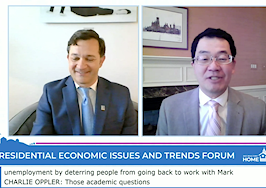Day 2 of Inman Connect is underway with an all-star lineup, including Opendoor’s Eric Wu, Keller Williams’ Wendy Papasan, and many more. Register now to watch the rest of the day today and tomorrow live, and catch up on what you missed on-demand.
Although the pandemic sparked a plethora of employment, health and housing challenges, it also provided a unique opportunity for millions of professionals to seize their dream of living in picturesque places like Tahoe and Big Sky full-time or at least part of the year.
Mortgage-rate locks for second homes skyrocketed by as much as 100 percent year over year in 2020, which have cooled to 48 percent annual growth as the new normal for Americans, especially in terms of employment and housing, comes into view.

Mauricio Umansky | Credit: The Agency
“I think [2020] was the year where people learned to seize the day,” The Agency founder and CEO Mauricio Umansky said to the Inman Connect crowd on Wednesday. “[We] saw a tremendous amount of people moving and changing where they’re going to be working [and] where they’re going to be living.”
“I do believe [second-homeownership] is sustainable,” he added. “I don’t think that we will continue to see this curve that we’ve seen that is just [like] a hockey-stick up curve. But I do believe we’re going to continue to see sustainability; a little bit of a flatter curve.”
Umansky said The Agency’s clients are experienced homebuyers who have purchased multiple properties throughout their lifetime and often own more than one home at a time. The pandemic, he said, didn’t stop their purchasing plans as they navigated working across state and international lines.
“Each location is different and that’s one of the things that you have to understand and learn,” he explained. “The contracts are different in California than they are in Colorado, or in Turks and Caicos or wherever it is that you’re looking.”
“What we have to do is deliver a super high level of service sometimes to their attorneys, sometimes with different people [on their teams] and really explain the differences that they might be accustomed to having,” he added while mentioning differences in contracts and how contingencies are handled.

Austin Allison | Pacaso
While the second-home market will undoubtedly continue to include and be driven by well-to-do homebuyers like Umansky’s, Pacaso co-founder Austin Allison said co-ownership models are opening the door for everyday professionals to get their piece of the second-home pie.
“We’re on a mission to make second-homeownership possible and enjoyable for more people and we do that through this concept of co-ownership, which basically means that a small group of vetted families are able to own a [second] home together, and our company provides a service that manages all the details from designing the home to paying the bills, to coordinating repairs and maintenance,” Allison said.
“What makes the concept really timely in this environment is that there’s a lot of people who are now rethinking how and where they live and work post-pandemic, and second homes are more top of mind than ever before,” he added. “The number one thing that prevents people from realizing their dream of second-homeownership is cost, and the number two thing is [the] hassle.”
Allison said co-ownership models are an additional path to sustainability for the second-home market and provide an avenue for homebuyers to snap up luxury homes that have been languishing on the market due to price.
“[Pacaso] is taking people who would have otherwise been buying at the median price, and it’s moving them into the luxury price tier,” he explained. “So if you’re a family in San Francisco and have $750,000 to spend in Napa, Tahoe or Truckee, you’re buying at the median price there.”
“What Pacaso does is make better use of the existing housing stock because a lot of these second homes sit vacant, and in markets like Napa and many other parts of the country, you actually are not allowed to rent these homes out on a short-term basis,” he added. “These homes sit vacant for 10 to 11 months per year, and the only thing better than building new homes to keep up with the demand is to make better use of the existing housing stock.”
Although the co-ownership model lowers the financial barrier to second-homeownership, Umansky said the model also lowers the future financial return of owning a second home outright.
“I think it’s fun for people to be able to own homes they generally wouldn’t be able to own because of the affordability concept. But keep in mind, if you’re buying a vacation home, it doesn’t generally sit empty unless you can afford to let it sit empty,” he said. “One of the advantages of having a secondary or tertiary homeownership is that you can lease it out and in many cases, you can actually have a positive cash flow.”
“The positive cash flow is actually paying off the mortgage and at the end of 15 to 20 years, you’ll own a whole bunch of property that you’ve been able to enjoy, and have an amazing retirement fund that hopefully has appreciated as well,” he added.
Allison said he agreed with the perceived downside to co-ownership models, but said homeowners who use Pacaso aren’t necessarily concerned with real estate investing and are more focused on the personal benefit of owning a getaway spot.
“One of the things that we found in our survey and just in lots of conversations with our owners, is many people don’t really like the idea of having renters in their home,” he said. “They actually prefer the peace of mind of knowing that it’s just a small group of other like-minded owners that are using the home with them.”
Both agreed that co-ownership and traditional homeownership models have their merits and are both crucial to keeping the second-home market humming as Americans figure out what late-stage-pandemic life looks like.
“There are different flavors of ice cream in an ice cream shop, right?” Umansky said. “Just like that, I think there’s room for both [models], and they give a different opportunity.”







